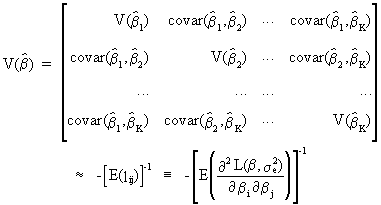V.I.2
Univariate Stochastic ARIMA Model Estimation
The
estimation of ARMA parameters in practice is not straightforward.
Though many computer algorithms and computer programs exist for ARMA
estimation, care should be taken with respect to some important
aspects. Since it is not our intention to go to far into the details
of estimation algorithms, only some important pitfalls and problems
are considered. These problems are especially interesting
(important) for those who seek to apply the methodology in practice.
First,
consider the formulation of the likelihood function. An ARIMA model
contains three different kinds of parameters:
 |
the
p AR-parameters; | |
 |
the
q MA-parameters; | |
 |
and
the variance of the error term. | |
This
amount to a total of p + q + 1 parameters to be estimated (see also remark).
These parameters are always estimated on using the stationary time
series (c.q. a time series which is stationary with respect to
itís variance and mean): sometimes
it is necessary to introduce an additional parameter m (a constant
term) to be estimated such that the total amount of parameters to be
estimated is p + q + 2.


(V.I.2-1)
likelihood
function holds true.
The
so-called log-likelihood function is

(V.I.2-2)
where
SSR is the Sum
of Squared Residuals



Box
and Jenkins (1976) showed that the exact
log-likelihood of an ARIMA model can be written as

(V.I.2-4)

Note
the following definitions

(V.I.2-5)
and

(V.I.2-6)
Hence,
using (V.I.2-4), it follows that

(V.I.2-7)
The
backforecasting procedure is identical to the forecasting algorithm,
except that the stationary time series is used in reversed order. Q'
is identified by some criteria which ensure that the backforecasts
have converged. This means that the backforecast should not be
significantly different from the (zero) mean of e(t).
If
backforecasting is not used (c.q. if the conditional likelihood
criterion is used) the parameter estimates may deviate severely from
the true parameters. Especially if the model contains MA parameters,
exact likelihood estimation is necessary (see also the
"truncation remainder").
Note
that the variance-covariance matrix of the estimated parameters is given by
the inverse of the information matrix

(V.I.2-8)
which
is derived from the likelihood function. Hence, not only the
parameter estimation, but also the variances of the parameters are
dependent on the use of the backforecasting procedure.


(V.I.2-9)
The
large sample variance can
be shown to be

(V.I.2-10)
Above
that, Box and Jenkins prove that

and

are
uncorrelated (for large samples). In fact, almost all estimation
properties in time series analysis are large sample properties. The
MLE estimates for ARIMA parameters are consistent,
normally distributed, and asymptotically
efficient.
It
is possible that an estimation algorithm yields parameter values for
an MA-process which lie outside the invertibility region. In such a
case it is possible to find a SSR which is smaller than the true
minimum.
The
estimation process can be adequately performed by Marquardt's
algorithm for nonlinear least squares as described in many
references (BOX and JENKINS 1976), (MELARD 1984), (GARDNER, HARVEY,
and PHILLIPS), etc...
Remark
Remark
that it is assumed that there is no seasonality involved in the
ARIMA process. In the case of seasonality, there would be p + P + q
+ Q + 1 parameters (P and Q being the seasonal counterparts of p and
q respectively). Furthermore it is assumed that no constant term is
required in the ARIMA process. | 
